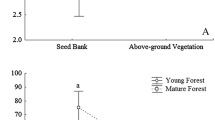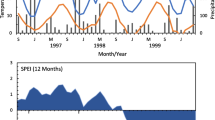Abstract
Four hypotheses were tested using long-term observations of vegetation development (12 years) and present-day seed bank data in a sandy grassland area overgrazed by domestic geese: i) Gap regeneration is crucial in maintaining species richness; thus, closed vegetation of the lower sites prevents continuous establishment of short-lived species. ii) Short-lived, early successional species comprise most of the seed banks and late successional perennials have at most sparse seed banks. iii) Composition of seed banks is more similar to pioneer vegetation than to later successional stages. iv) The similarity is higher between vegetation and seed banks in the upper-positioned plots than in the closed, lower-positioned ones. Two sites, located in the upper part of dune slopes, and another two, positioned on the lower part, were studied. In each site five 2 × 2 m permanent plots were surveyed between 1991 and 2002. Percentage cover was estimated three times a year. In the last study year, soil seed banks were sampled. Two vertical segments (0–5, 5–10 cm) were separately analyzed. The seedling emergence method was applied on concentrated samples. We found that the vegetation developed from open, annual dominated weedy assemblages to grasslands dominated by perennial graminoids. In the lower-positioned sites perennial clonal grasses (Cynodon dactylon, Poa angustifolia and P. pratensis) formed more closed vegetation, which was accompanied by lower species richness compared to the upper-positioned sites. Seed density varied between 10,300 and 40,900 seeds/m2. Significantly higher seed densities were found in upper sites than in the lower ones. Annuals and short-lived perennial dicots comprised most of the seed bank. The dominant perennial graminoids also built up dense seed banks. We found a low to medium similarity between vegetation and the seed bank; similarity was the highest with the vegetation of the 1994–1998 period. In the upper sites the similarity between seed bank and the vegetation of the last studied years was also high. The vertical position had a significant effect on regeneration after overgrazing. The large cover of grasses in lower sites decreased species richness and it also decreased the seed density preventing the seed bank formation of annuals and short-lived perennials. Here, further management practices are needed to increase the species richness.


Similar content being viewed by others
Abbreviations
- Simon:
-
(2000) for taxa
- Borhidi:
-
(2003) for syntaxa
References
Bakker JP (1989) Nature management by grazing and cutting. Kluwer Academic Publishers, Dordrecht
Bakker JP, Poschlod P, Strykstra RJ, Bekker RM, Thompson K (1996) Seed banks and seed dispersal: important topics in restoration ecology. Acta Bot Neerl 45:461–490
Bakker JP, Bakker ES, Rosén E, Verweij GL (1997) The soil seed bank of undisturbed and disturbed dry limestone grassland on Öland (Sweden). Z Ökol Naturschutz 6:9–18
Bazzaz F (1979) Physiological ecology of plant succession. Annual Rev Ecol Syst 10:351–371
Bekker RM, Verweij GL, Smith REN, Reine R, Bakker JP, Schneider S (1997) Soil seed banks in European grasslands: Does land use affect regeneration perspectives? J Appl Ecol 34:1293–1310
Blanckenhagen von B, Poschlod P (2005) Restoration of calcareous grasslands: the role of the soil seed bank and seed dispersal for recolonisation processes. Biotechnol Agron Soc Environm 9:143–149
Borhidi A (1995) Social behaviour types, the naturalness and relative ecological indicator values of the higher plants in the Hungarian flora. Acta Bot Hung 39:97–101
Borhidi A (2003) The plant associations of Hungary. Akadémiai Kiadó, Budapest (In Hungarian)
Bossuyt B, Honnay O, Van Stichelen K, Hermy M, Van Assche J (2001) The effect of a complex land use history on the restoration possibilities of heathland in central Belgium. Belgian J Bot 134:29–40
Champness SS, Morris K (1948) The population of buried viable seeds in relation to contrasting pastures and soil types. J Ecol 36:149–173
Chang ER, Jefferies RL, Carleton TJ (2001) Relationship between vegetation and soil seed banks in an arctic coastal marsh. J Ecol 89:367–384
Cleveland WS (1979) Robust locally weighted regression and smoothing scatterplots. J Amer Statist Assoc 74:829–836
Csapody V (1968) Keimlingsbestimmungsbuch der Dikotyledonen. Akadémiai Kiadó, Budapest
Csontos P (1998) The applicability of a seed ecological database (SEED) in botanical research. Seed Sci Res 8:47–51
D'Angela E, Facelli JM, Jacobo E (1988) The role of the permanent soil seed bank in early stages of a post-agricultural succession in the Inland Pampa, Argentina. Vegetatio 74:39–45
Donath TW, Hölzel N, Otte A (2003) The impact of site conditions and seed dispersal on restoration success in alluvial meadows. Appl Veg Sci 6:13–22
Espigares T, Peco B (1993) Mediterranean pasture dynamics: the role of germination. J Veg Sci 4:189–194
Fekete G, Tuba Z, Melkó E (1988) Background processes at the population level during succession in grasslands on sand. Vegetatio 77:33–41
Fenner M (1978) Susceptibility to shade in seedlings of colonizing and closed turf species. New Phytol 81:739–744
Fenner M (1985) Seed ecology. Chapman and Hall, London
Fischer SF, Poschlod P, Beinlich B (1996) Experimental studies on the dispersal of plants and animals on sheep in calcareous grasslands. J Appl Ecol 33:1206–1222
Geißelbrecht-Taferner L, Geißelbrecht J, Mucina L (1997) Fine-scale spatial population patterns and mobility of winter-annual herbs in a dry grassland. J Veg Sci 8:209–216
Graham DJ, Hutchings MJ (1988) A field investigation of germination from the seed bank of a chalk grassland ley on formal arable land. J Appl Ecol 25:253–263
Handlová V, Münzbergová Z (2006) Seed banks of managed and degraded grasslands in the Krkonoše Mts., Czech Republic. Folia Geobot 41:275–288
Hölzel N, Otte A (2003) Restoration of a species-rich flood-meadow by topsoil removal and diaspore transfer with plant material. Appl Veg Sci 6:131–140
Jentsch A (2001) The significance of disturbance for vegetation dynamics in sandy grassland ecosystems. PhD Thesis, University of Bielefeld, Bielefeld
Jentsch A (2004) Disturbance driven vegetation dynamics. Cramer, Stuttgart
Jentsch A, Beyschlag W (2003) Vegetation ecology of dry acidic grasslands in the lowland area of Central Europe. Flora 198:3–25
Levassor C, Ortega M, Peco B (1990) Seed bank dynamics of Mediterranean pastures subject to mechanical disturbance. J Veg Sci 1:339–344
Maas D, Schopp-Guth A (1995) Seed banks in fen areas and their potential use in restoration ecology. In Wheeler BD, Shaw SC, Fojt WJ, Robertson RA (eds) Restoration of temperate wetlands. John Wiley & Sons, Chichester, pp 189–206
Matus G, Tóthmérész B (1994) Correlation of indicator values with climatic and soil data in a ruderal succession. Abstr Bot 18:7–12
Matus G, Tóthmérész B (1995) Pioneer phase of succession in a ruderal weed community. Acta Bot Hung 39:51–70
Matus G, Tóthmérész B, Papp M (2003) Restoration prospects of abandoned species-rich sandy grassland in Hungary. Appl Veg Sci 6:169–178
Matus G, Papp M, Tóthmérész B (2005) Impact of management on vegetation dynamics and seed bank formation of inland dune grassland in Hungary. Flora 200:296–306
McDonald AW, Bakker JP, Vegelin K (1996) Seed bank classification and its importance for restoration of species-rich flood-meadows. J Veg Sci 7:157–164
Odum EP (1969) The strategy of ecosystem development. Science 164:262–270
Peco B, Ortega M, Levassor C (1998) Similarity between seed bank and vegetation in Mediterranean grassland: a predictive model. J Veg Sci 9:815–828
Poschlod P, Jackel A (1993) Untersuchungen zur Dynamik von generativen Diasporenbanken von Samenpflanzen in Kalkmagerrasen. Flora 188:49–71
Poschlod P, Kiefer S, Tränkle U, Fischer S, Bonn S (1998) Plant species richness in calcareous grasslands as affected by dispersability in space and time. Appl Veg Sci 1:75–90
R Development Core Team (2008) A language and environment for statistical computing. R Foundation for Statistical Computing, Vienna. Available at: http://www.R-project.org
Rebollo S, Pérez-Camacho L, García-de Juan MT, Rey Benayas JM, Gómez-Sal A (2001) Recruitment in a Mediterranean annual plant community: seed bank, emergence, litter and intra- and inter-specific interactions. Oikos 95:485–495
Schwabe A, Storm C, Zeuch M, Kleine-Weischede H, Krolupper N (2000) Sandökosysteme in Südhessen: Status quo, jüngste veränderungen und Folgerungen für Naturschutz-maβnamen. Geobot Kolloq 15:25–45
Simon T (2000) A magyarországi edényes flóra határozója (Vascular flora of Hungary). Nemzeti Tankönyvkiadó, Budapest (In Hungarian)
Smith RS, Shiel RS, Millward D, Corkhill P, Sanderson RA (2002) Soil seed banks and the effects of meadow management on vegetation change in a 10-year meadow field trial. J Appl Ecol 39:279–293
Soó R (1957) Conspectus des groupements végétaux dans les Bassins Carpathiques II. Les associations psammophiles et leur génétique. Acta Bot Acad Sci Hung 3:45–64
Stroh M, Storm C, Zehm A, Schwabe A (2002) Restorative grazing as a tool for directed succession with diaspore inoculation: the model of sand ecosystems. Phytocoenologia 32:595–625
Symonides E (1978) Number, distribution and specific composition of diaspores in the soil of the plant association Spergulo-Corynephoretum. Ekol Polska 26:111–122
Symonides E (1979) The structure and population dynamics of psammophytes on inland dunes. IV. Population phenomena as a phytocenose-forming factor (A summing-up discussion). Ekol Polska 27:259–281
ter Heerdt GNJ, Verweij GL, Bekker RM, Bakker JP (1996) An improved method for seed bank analysis: seedling emergence after removing the soil by sieving. Funct Ecol 10:144–151
Thompson K (1986) Small-scale heterogeneity in the seed bank of an acidic grassland. J Ecol 74:733–738
Thompson K (1992) The functional ecology of seed banks. In Fenner M (eds) Seeds: the ecology of regeneration in plant communities. CAB International, Wallingford, pp 231–258
Thompson K, Bakker JP, Bekker RM (1997) The soil seed banks of North West Europe: methodology, density and longevity. Cambridge University Press, Cambridge
Török P, Matus G, Papp M, Tóthmérész B (2008) Secondary succession in overgrazed Pannonian sandy grasslands. Preslia 80:73–85
Tsuyuzaki S, Fusayuki K (1992) Revegetation Patterns and Seedbank Structure on Abandoned Pastures in Northern Japan. Amer J Bot 83:1422–1428
Wagner M, Poschlod P, Setchfield RP (2003) Soil seed bank in managed and abandoned semi-natural meadows in Soomaa National Park, Estonia. Ann Bot Fenn 40:87–100
Willems JH (1995) Soil seed bank, seedling recruitment and actual species composition in an old and isolated chalk grassland site. Folia Geobot 30:141–156
Zar JH (1999) Biostatistical analysis. Prentice Hall, Upper Saddle River, NJ
Acknowledgements
The authors are thankful to the staff of Debrecen University Botanical Garden for providing facilities as well as L. Karaffa and E. Fekete at the Genetical and Applied Microbiological Department for their help in sterilizing potting soils. Soil analyses were carried out at the Pedological Laboratory of Plant and Soil Protection Station (NETVÁ; E. Nyeste, B. Harman). Meteorological records were kindly provided at TIVIZIG (G. Búti, Zs. Kovács). Help of students (L. Fodor, Cs. György, F. Ifi, L. Nagy, G. Sramkó, Zs. K. Szabó) given in field surveys is acknowledged. The research was supported by the OTKA (T/15 42848, T/19 67748), Békésy Postdoctoral Fellowship (Ministry of Education, 2003–2005). We thank T. Herben, R. Hédl and two anonymous reviewers for comments on the manuscript.
Author information
Authors and Affiliations
Corresponding author
Appendix 1
Appendix 1
Rights and permissions
About this article
Cite this article
Török, P., Matus, G., Papp, M. et al. Seed Bank and Vegetation Development of Sandy Grasslands After Goose Breeding. Folia Geobot 44, 31–46 (2009). https://doi.org/10.1007/s12224-009-9027-z
Received:
Revised:
Accepted:
Published:
Issue Date:
DOI: https://doi.org/10.1007/s12224-009-9027-z




